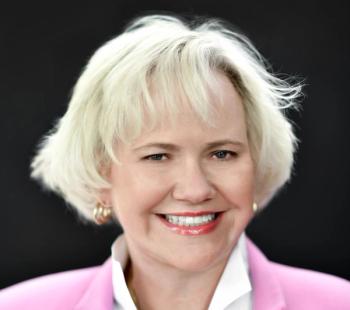
Hospital workers and well-being: ‘It’s a problem with our industry and it’s ours to fix’

The health of an organization’s staff has a direct impact on both patient care and the bottom line, wellness experts say. They outline some steps to help.
Hospitals and health systems need to see the well-being of their staff members as a key quality indicator.
Kristine Olson, chief wellness officer at Yale New Haven Hospital, highlights the link between well-being and patient outcomes.
“If we’re trying to have high-quality patient-centered care, that’s not possible without the well-being of your workforce,” she said.
Olson and other healthcare wellness leaders talked about the immense pressures on the well-being of employees during a panel session at the
“It's a problem with our industry and it's ours to fix,” Olson said. “And we can't do it without leadership across the hospitals.”
Nigel Girgrah, chief wellness officer and medical director of liver transplantation at Ochsner Health, New Orleans, says employee well-being affects all aspects of the hospital.
“I think it's the leading quality indicator that drives everything we aspire to be as a profession, as a health system, in terms of patient experience, population health outcomes, quality, safety,” Girgrah says.
Olson also viewed workforce well being as a key ingredient to high-quality, patient-centered care.
“The performance and the well-being of your workforce is probably your most valuable piece of the puzzle,” she said.
When workers withdraw
Wellness leaders stressed the financial impact on the well-being of workers.
Stefanie Simmons, chief medical officer of the
She also pointed to “being able to effectively recruit, retain and engage your workforce, and all of that is built on the professional well-being of that workforce.”
The cost of replacing a physician can range from $500,000 to $1.5 million, Olson said.
“You could lose whole service lines,” Olson said. “So you want to be ahead of that so you don't find yourself in that vulnerable position.”
Some workers demonstrate dissatisfaction and burnout before they walk out the door.
“We know that there are different ways that people will physically withdraw from your practice,” Olson said.
“They will reduce their FTE, they will reroute into non-clinical work, they will restrict the scope of work that they're doing, they will relocate … retire early,” she added. “They will leave you physically or they will leave you psychologically, where they are present but they are not totally engaged in the work that they're doing.”
Olson also pointed to the rise of risky behaviors, such as substance use, and the greater risk of suicide.
‘Start somewhere’
Wellness leaders acknowledge that improving well-being can seem like a difficult task.
“It can be overwhelming,” Girgrah said. “And I just want to caution folks it's very easy to come up with like 140 great ideas to fix healthcare tomorrow, but unless it's a certain part of the strategic framework, it’s not as likely to be successful.”
“That being said, just try and start somewhere,” he added.
Simmons stressed the idea of taking small but measurable steps to see progress. She said it can be broken down into “evidenced-informed, bite-sized pieces.”
“Every part of the system of healthcare impacts the professional well-being of the workforce,” she said. “There are actionable steps that can be taken to improve the professional well being of the workforce without having to fix everything right away.”
Healthcare leaders stressed the importance of getting the backing of hospital executives and their boards on efforts to improve staff well-being. They also talked about linking well-being to the goals across the organizations, including patient care and improved financial performance.
Wellness leaders should work to develop “a critical mass of people who are on your side and be able to remove roadblocks,” Girgrah said.
Listen to workers
Hospitals need to be asking their workers about their well-being, and if they feel supported in their work.
Amanda Nichols, clinical manager of Aya Healthcare, a travel nursing company, talked about the insights her organization gained from surveying nurses. Over the past few years,
“During the pandemic, we really could see a shift in the workforce, the increasing nursing shortage and a change in the mental and physical well being of our travelers,” Nichols said.
She said Aya surveyed nurses to find out why they stay in their roles and when they are motivated to make a change.
‘“The pandemic work experiences had a profound impact on nurses’ mental health,” Nichols said. “There were a lot of career changes. They just chose to leave and do different things.”
“But one unexpected yet profound message resonated from each of the participants,” she added. “And this message was: no one asked me: ‘Are you okay?’”
Yale New Haven conducts surveys of staff well-being every 18 months, Olson said. She says that allows time to gather responses and also develop action plans to address workers’ concerns.
“People do not want to get surveyed constantly,” Olson said. “So you really do have to have accountability back to the constituents that you serve, to keep them engaged … to know that their input is being heard.”
Ochsner surveys staff every 12 months, and Girgrah says he’s becoming concerned with “survey fatigue.”
“We’ve done that for five years,” he said. “I'm starting to think that may be too frequent.”
While the frequency of surveying can be debated, wellness leaders stressed that hospitals need to be talking to their workers, and they need to listen to what they have to say.
They also need to take action, even in small steps. Workers don’t want to be asked about their concerns only to find out nothing is being done.
“We really need to create the best platform on which these professionals can live up to their calling, and to be really masterful in their work,” Olson said.
Simmons says she has been encouraged by the way organizations have come together to help healthcare workers, and the greater attention on their well-being.
“We all need to address the issue of professional well-being in healthcare in order for any of us to be successful,” Simmons said.






















































































